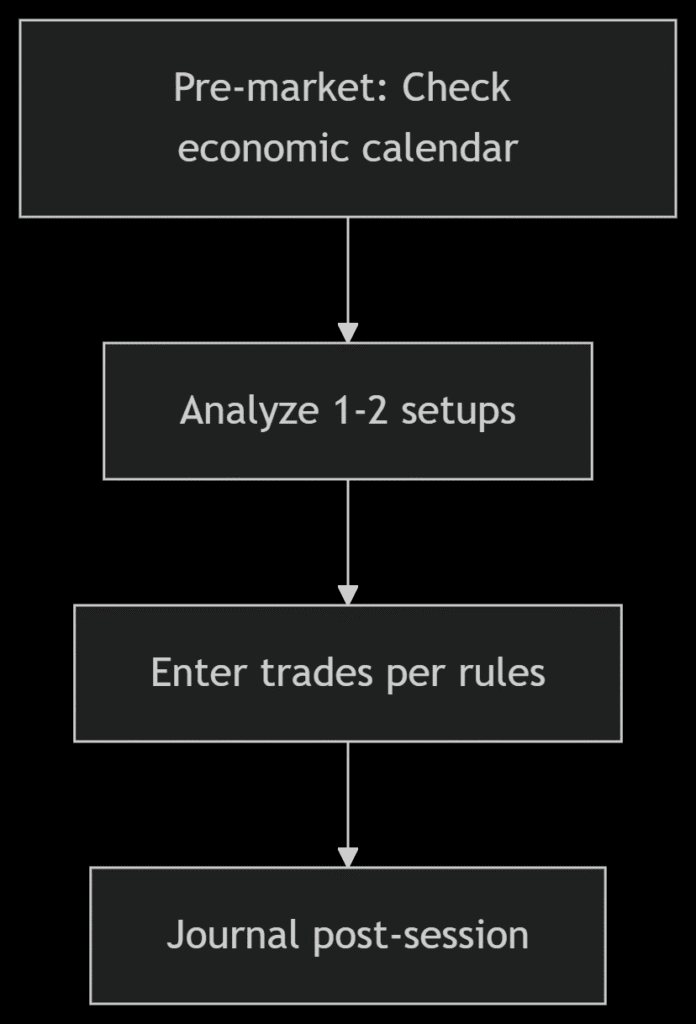A forex trading plan is your battle-tested blueprint for navigating the $6.6 trillion currency market. Without one, 90% of traders blow accounts within 6 months (CFTC 2024). This step-by-step 2025 guide transforms vague hopes into structured rules—covering strategy selection, risk limits, and psychological discipline for consistent profits.
What Is a Forex Trading Plan?
A forex trading plan is a written document specifying:
- WHAT you trade (currency pairs, sessions)
- HOW you trade (entry/exit rules)
- WHEN you trade (schedule, triggers)
- WHY each rule exists (risk logic)
It’s non-negotiable: Professionals treat plans like flight checklists—amateurs wing it.

5 Proven Benefits of a Trading Plan
- Kills Emotional Trading:
- Rules prevent revenge trades after losses
- Builds Consistency:
- 78% of profitable traders follow plans religiously (MyFxBook Study)
- Measures Progress:
- Track ROI against predefined targets
- Simplifies Scaling:
- Clear rules for increasing capital allocation
- Provides Accountability:
- Journal exposes rule violations
Key Components of a Winning Forex Trading Plan
1. Trading Goals (Realistic & Quantifiable)
- Bad: “Make money”
- Good: “3% monthly ROI, max 5% monthly drawdown”
2. Market Session & Currency Pairs
- Example:“Trade London session (07:00-10:00 UTC) only; focus on EUR/USD and GBP/USD”
3. Strategy Rules (Entry/Exit Setup)
- Entry:“Buy when EMA 50 > EMA 200 + RSI >30 at daily support”
- Exit:“Sell at 1:3 risk-reward or when EMA 50 flattens”
4. Risk Management Protocol
| Rule Type | Example |
|---|---|
| % Risk per Trade | Max 1% of account |
| Stop-Loss | 1.5x ATR from entry |
| Lot Size | Micro lots only ($0.10/pip) |
5. Psychological Safeguards
- “Max 3 trades/day”
- “Stop trading after 2 consecutive losses”
- “Mandatory 24hr break if monthly drawdown >5%”
6. Daily Routine

Build Your Plan in 7 Steps (Template Included)
- Choose Your Strategy (Test 3 months historical data):
- Scalping: 5-10 pip targets
- Swing: 50-200 pip targets
- Set Risk Tolerance:
- Conservative: ≤1% per trade
- Aggressive: ≤3% (only for >$10K accounts)
- Define Trading Schedule:
- Match sessions to strategy (e.g., London overlap for EUR/USD scalping)
- Backtest Rigorously:
- Use TradingView replay mode
- 100+ trades for statistical significance
- Forward Test on Demo:
- 1 month minimum with real-market conditions
- Create Rules Checklist:
- Launch & Monitor:
- Start with 50% position sizes for first 20 trades
Testing & Optimizing Your Plan: The Trader’s Feedback Loop
Trade Journal Essentials:
| Field | Purpose |
|---|---|
| Entry/Exit Reason | Verify rule compliance |
| Emotional State | Identify tilt triggers |
| Screenshot | Visual review of setups |
🔄 Improvement Cycle: Review journal weekly → Tweak 1 variable monthly → Never overhaul mid-drawdown.
5 Deadly Mistakes to Avoid
- Vagueness Kill Plans:
- ❌ “Trade reversals sometimes”
- ✅ “Trade RSI <30 bounces at daily support only”
- Ignoring Risk Caps:
- 5% drawdown = 26% harder recovery (MyFxBook)
- Copy-Pasting Plans:
- Your sleep schedule ≠ New York session scalper’s
- Overcomplicating:
- Max 3 indicators + 2 currency pairs
- Skipping Backtesting:
- 92% of untested strategies fail live (Journal of Trading 2024)
Conclusion: Your Blueprint for Consistency
A robust forex trading plan forces discipline—turning emotional reactions into systematic execution. Remember:
- Beginners: Start with micro lots + 1 strategy
- Intermediate: Add pairs only after 6 profitable months
- Experts: Refine risk rules quarterly
❓FAQs – Forex Trading Plan
Q: What is a forex trading plan?
A: A written set of rules covering what you trade, how you enter/exit, risk limits, and psychological safeguards.
Q: How detailed should my trading plan be?
A: Extremely specific—e.g., “Risk 1% per trade, exit at 1:3 RR or when EMA 20 crosses against position.”
Q: Do I need a trading plan if I only scalp?
A: Absolutely! Scalping requires tighter rules (e.g., max 2% daily loss cap, 5-pip stop losses).
Q: Can I use someone else’s trading plan?
A: As inspiration only—adapt every rule to your risk tolerance, schedule, and psychological triggers.
Q: How often should I update my trading plan?
A: Review monthly, adjust quarterly. Never change rules during drawdowns.


![What Is Forex Trading and How Does It Work? [2025 Best Beginner’s Guide] What is Forex trading diagram](https://forexbrokeredge.com/wp-content/uploads/2025/07/steptodown.com387397-1024x683.jpg)
![Forex Market Sessions: Best Time to Trade for Each Currency Pair [New 2025 Guide] Forex Market Sessions: Best Time to Trade for Each Currency Pair [New 2025 Guide]](https://forexbrokeredge.com/wp-content/uploads/2025/07/sessions-stock-1024x554.jpg)